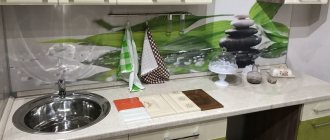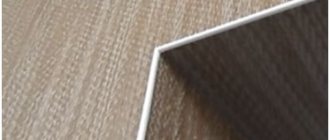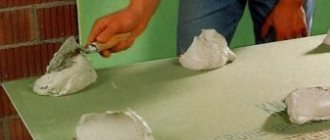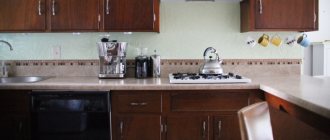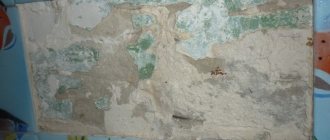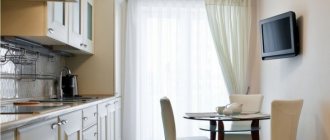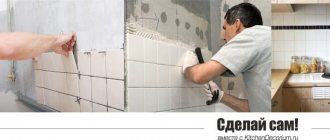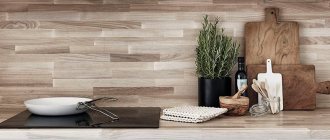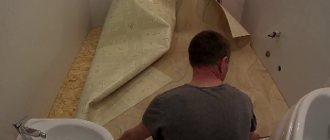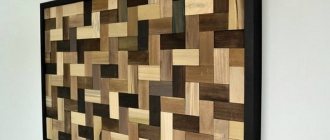The kitchen apron is the vertical section of the wall between the hanging cabinets in the kitchen and the countertop. This is a visible part that gets dirty all the time, since it is located next to the countertop, where food is cut, and the stove. Therefore, the main requirements for an apron are that it be convenient and practical to use, not easily soiled, easy to wash, resistant to temperature differences and chemicals, and also maintain an attractive appearance. Well, of course, he pleased his mistress.
Review of advantages and disadvantages
Why are plastic panels so popular? Yes, because plastic has its advantages:
- They are water tolerant. Plastic is not afraid of water, so it is easy to wash. And this is a huge plus for any housewife.
- Easy installation. To install a plastic panel, it is not necessary to have smooth walls (unless the materials require it). The installation is so easy that anyone can do it without much effort.
- Design. You can apply a design to the plastic that your soul desires.
- Low price. Plastic panels are often confused with glass. But the former are much cheaper than glass.
There are many advantages, but there are also disadvantages:
- Not tolerant of fire. Since it is plastic, it melts when exposed to fire. And then he gives way to the same glass.
- Fragility. If not properly cared for, the plastic panel loses its former appearance and is prone to damage. With the appearance of scratches, stains, and clouding of the surface, such a panel no longer looks aesthetically pleasing. Therefore, there is a possibility that it will need to be changed periodically.
- Not environmentally friendly material. When plastic is exposed to fire, it begins to melt, releasing substances harmful to health. But now they are making better quality and environmentally friendly products. A special certificate allows you to find out how environmentally friendly a product is.
- Rapid loss of color. Over time, the panel fades and loses its original shade and begins to turn yellow. But there are panels that contain UV-resistant pigments. But they are more expensive.
Concrete
Concrete can give a home kitchen a dramatic, industrial look and has many of the same benefits as natural stone:
- It is strong and durable.
- Resistant to heat.
- When properly sealed, it is also stain and moisture resistant.
- In addition, this type of finishing has an acceptable cost.
- The only noticeable disadvantage of concrete is its appearance. The material will not fit into every interior. Concrete splashbacks are suitable for country style kitchens and minimalist style kitchens.
What types of plastic aprons are there?
There are three types of plastic aprons. They differ in material, price and quality.
ABS work wall
These are flexible sheets. They are lighter than glass, environmentally friendly, tolerant of chemicals, and decorative. This material bears the abbreviation (ABS), which means the names of the substances from which the material is made: Acrylonitrile, Butadiene, Styrene.
In addition to the above-mentioned advantages, an ABS wall has disadvantages: the presence of a yellow tint, tolerates only soft textures for washing, and fades quickly.
Polycarbonate panel
One of the highest quality materials. It has a lot of advantages and a minimum of disadvantages.
This material does not fade, it is impact-resistant, it looks no different from glass, and it is tolerant of fire. You can apply absolutely any design to it, so you can use it to create a unique interior design. Among the shortcomings, the most primitive can be identified: it scratches in the same way as all types of plastic. It's a shame that it wears out just like the cheaper ones.
Apron made of acrylic glass (polycarbonate, plexiglass)
In appearance, acrylic glass is no different from silicate glass. It is smooth, transparent, durable, but costs less.
Such a panel can be either transparent or multi-colored.
Acrylic glass does an excellent job of protecting walls from stains and other damage. Anyone can install such glass, but this material requires careful use.
Plastic aprons with fruit and berry designs and flowers
The print of fruits and flowers on a plastic panel for the kitchen looks impressive and bright. This image is suitable for a kitchen whose furniture is decorated in one shade. The shade should not be bright and catchy.
If the shades of the set are bright, then a floral-fruit print will be superfluous. An abundance of variegation will not add aesthetics.
But such a print is suitable in an interior where monochromatic, dim shades of furniture and furniture predominate. Furniture should be of ordinary, simple shape. Then a bright floral print will dilute the color scheme and add piquancy to the design.
Plastic aprons with natural textures
They are made to look like wood or stone.
Plastic aprons with a mirror surface
This idea is good because a large number of mirrors visually enlarges the room. Therefore, a plastic apron with a mirror surface will significantly enlarge the room (visually). That's a plus.
Kitchen apron with mirror finish
But there is a minus: every drop on the mirror will be visible, you will have to carefully wipe it off, because it looks dirty and not beautiful. But plastic doesn’t like friction, it can get scratched, and streaks can also appear.
Self-adhesive mosaic: what is it
Indeed, today a kitchen apron can be made using this type of mosaic.
This coating is perfect for flat, smooth walls.
Features of self-adhesive mosaic:
- It is kept on the surface by a special film;
- This mosaic looks like a slab, with decor on one side and adhesive on the other;
- The thickness of such a plate reaches half a centimeter;
- To attach it, simply level the surface.
Self-adhesive mosaic is deservedly considered the most interesting and effective finishing material for decorating kitchens.
And then it’s simple - the special layer is removed, exposing the adhesive part, the mosaic is applied to the wall, and it is fixed in two or three minutes.
It is very important to attach this slab correctly during installation, since it will then be impossible to separate it from the wall (at least without consequences).
The front part of such a mosaic is specially divided into cells, into which decorative elements are laid in a special way, due to which the texture and relief are maintained.
How much does a plastic apron cost for the kitchen?
There is no single price for all materials. Prices vary according to quality, manufacturer, material, etc. If all criteria are at the highest level, then the price will be higher. And if not everything is good, for example, with quality, then the price will be much lower.
When choosing a panel for your kitchen, you should not focus only on expensive, branded materials. It is not a fact that branded material will last for many years. Over time, you will still have to replace the plastic apron, no matter what it is (expensive or cheap). Therefore, there is no point in wasting money. But the cheapest materials are also not worth taking. Otherwise, you will have to change it many times more often, money will go down the drain, and you don’t want to go through the hassle of installing it every time. A good option is to take something that matches the parameters and your preferences. In this case, you will be satisfied.
How to lay tiles in a mosaic correctly
Treat the wall with glue, but very carefully, evenly and not in a very greasy layer. For laying out, special plastic crosses are often used.
Features of laying out mosaics:
- Any tile, no matter what design it is, must be laid out horizontally. This is what makes it lie flat.
- Lay the first row vertically, and then follow this row as a guide.
- Each tile must be carefully coated with glue and applied to the wall.
- If you use a grid, then first glue it to the wall, and then lay the tiles in the cells, securing them securely.
For creative people, the most interesting and exciting part of the job will be pasting the mosaic onto the wall.
The seams on the tiles can be grouted by hand, or you can do it with a gun.
In most cases, a mesh with a mosaic is purchased, which greatly simplifies all manipulations; you just need to glue the mesh onto a flat surface - and your kitchen apron is ready.
Customer reviews about plastic apron
Based on customer reviews, you can understand that polycarbonate plastic aprons are the best in quality. It's best to buy them. They are wear-resistant and relatively inexpensive.
The ABS wall is in second place, as it does not have some of the qualities that the previous material has.
In last place are aprons made of acrylic glass. That's not to say they're terrible. Not at all, they are worth purchasing. It’s just that the previous two materials most closely correspond to the price = quality scheme.
Arina Volkova: “I love working with tiles and porcelain stoneware”
Designer Arina Volkova.
Designer Arina Volkova.
“There are quite a lot of options for finishing the apron. I think the most popular answer among designers will be quartz agglomerate. They love it for its strength, size, and accessibility. But plasters, glass and plastics are long gone due to their fragility and impracticality.
Natural stones will always be relevant. Of course, among them there are both difficult to care for and more practical options. Granite, marble, onyx are always beautiful. Few things compare in beauty to natural materials.
Fragment of the kitchen.
Author of the project: Arina Volkova. Photo: Alexander Dyachkov.
Fragment of the kitchen.
Author of the project: Arina Volkova. Photo: Alexander Dyachkov.
I love working with tiles and porcelain tiles. Ceramics are affordable, easy to clean, and have a huge number of options for colors, textures, formats, and designs. An apron can look like stone, concrete, like textiles, have any pattern and at the same time be durable and easy to clean.
Large-format porcelain tiles have long entered the market. For me, it is now in first place in finishing aprons and countertops. It's all about a single pattern over the entire area, no seams, a strong, flat surface. This is a story about the ideal combination of the principles of architecture: utility, strength and beauty.”
DIY installation of a plastic apron in the kitchen
To install an apron in the kitchen, you first need to decide on its size. It should protrude beyond the tabletop by a couple of centimeters. It can be any height at your discretion.
Then you need to cut the plastic sheets or panels with a fine-toothed hacksaw. Next, we fix the panel on the wall. There are several ways to do this:
On the guides
Mounting on guides is a mounting on metal slats. Since plastic is inexpensive and requires periodic replacement, it is not worthwhile to “tightly” attach a plastic apron. If you know that you will soon be attaching a new panel again, then the guides will allow you to remove the old one without any problems.
The guides themselves are attached to the wall with self-tapping screws, and the panel is inserted into these guides as if on rails.
For self-tapping screws
This mounting option is suitable if you do not plan to replace the panel in the near future, you need to attach it thoroughly. Attaching a plastic panel with self-tapping screws is not difficult. But for this you need to have perfectly smooth walls.
By installing a plastic apron in the kitchen in this way, a free space is created between it and the wall into which wiring can be placed. This way the interior will be more aesthetically pleasing.
On the sheathing
The lathing consists of wooden or metal bars that are attached to the wall along the perimeter of the plastic panel itself. This method is suitable for a fairly large room. If the wall is uneven, then the lathing will solve this problem; it is not afraid of unevenness on the wall. The panel itself is attached with self-tapping screws to these bars. There will be free space between the panel and the wall where you can also hide the wiring.
On glue
This option is the simplest and fastest. Even a person inexperienced in this matter will be able to glue a plastic apron to the wall. The main thing is to have a high-quality adhesive composition. In addition to glue, you can use liquid nails for fastening. This option is more convenient. Since there is more hassle with glue: it needs to be applied in strips to the wall, maintaining a certain distance between them. With liquid nails everything is much easier and faster.
This method, of course, is fast and convenient, but it also requires perfectly smooth walls.
Photos of kitchens with acrylic facades
The following video will help you see clearly what a modern acrylic kitchen is.
Kitchen apron made of plastic photo: best design ideas
Let's summarize everything that has been said: there are several types of plastic aprons for walls in the kitchen, each material (for making aprons) has its pros and cons, all materials differ from each other in terms of criteria, there are 4 ways to attach the panel.
Now, having enough knowledge on this topic, every beginner will be able to install a plastic apron in the kitchen themselves. There's nothing complicated about it.
